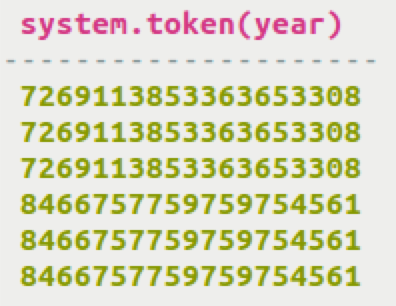Displaying rows from an unordered partitioner with the TOKEN function
How to use CQL to display rows from an unordered partitioner.
The ByteOrdered partitioner arranges tokens the same way as key values, but the RandomPartitioner and Murmur3Partitioner distribute tokens in a completely unordered manner. When using the RandomPartitioner or Murmur3Partitioner, Cassandra rows are ordered by the hash of their partition key, or for one partition queries, rows are ordered by their clustering key. Hence, the order of rows is not meaningful, because of the hashes generated.
To order the rows for display when using RandomPartitioner or Murmur3Partitioner, the
token function may be used. However, ordering with the TOKEN
function does not always provide the expected results. Use the
TOKEN function to express a conditional relation on a partition
key column. In this case, the query returns rows based on the token of the partition
key rather than on the value.
The TOKEN function can also be used to select a range of partitions
for a ByteOrderedPartitioner. Using the TOKEN function with
ByteOrderedPartitioner will generally yield expected results.
TOKEN function depends on the type
of the columns used as the argument of the function. The return type depends on the
partitioner in use:- Murmur3Partitioner, bigint
- RandomPartitioner, varint
- ByteOrderedPartitioner, blob
Procedure
-
Select data based on a range of tokens of a particular column value.
SELECT * FROM cycling.last_3_days WHERE TOKEN(year) > TOKEN('2015-05-24');
-
The results will not always be consistent with expectations, because the token
function actually queries directly using tokens. Underneath, the token function
uses token-based comparisons and does not convert year to token (not year >
'2015-05-26').
SELECT * FROM cycling.last_3_days WHERE TOKEN(year) > TOKEN('2015-05-26');
-
Display the tokens for all values of the column
year.
SELECT TOKEN(year) FROM cycling.last_3_days;
-
Tokens and partition keys can be mixed in conditional statements. The results
will not always be straightforward, but they are not unexpected if you
understand what the
TOKENfunction does.SELECT * FROM cycling.last_3_days WHERE TOKEN(year) < TOKEN('2015-05-26') AND year IN ('2015-05-24','2015-05-25');
